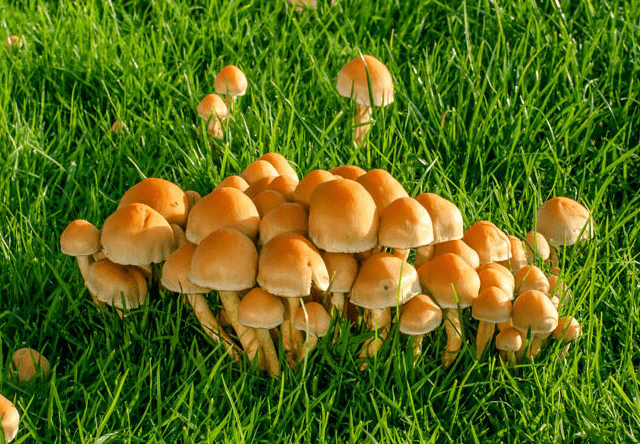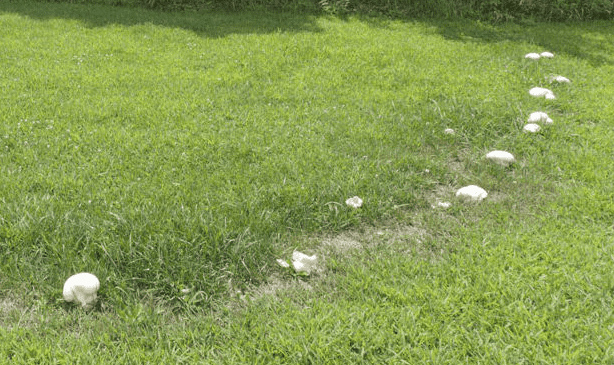Fungi, which include mushrooms, can grow in a variety of settings, including backyards, lawns, and woodlands. They procreate by dispersing spores into the atmosphere or water droplets.

Due to spores that were embedded in the potting soil or the mulch media that was utilized, mushrooms will grow in vegetable gardens and potted plants. They are helpful fungi that support plant growth by forming a symbiotic relationship with plants. Having mushrooms in the soil indicates a small yet thriving ecology.
We’ll explain why mushrooms proliferate in gardens and on houseplants in this article. Despite the fact that mushrooms can grow anywhere, there are a few things to watch out for when having them around. In order to respond to your inquiries about mushrooms growing in vegetable gardens and potted plants, we have conducted the necessary study.
Table of Contents
Why are Mushrooms Growing in the Garden?
Since they are so little, mushrooms cannot be seen with the human eye and instead grow from spores, not seeds as you might typically believe.
There are countless different types of mushrooms, and each one has unique qualities.
These spores don’t need soil to grow; instead, they need things like sawdust, straws, or wood chips.
These spores also belong to the fungi category and are good for the soil because they help with the process of decomposition, which releases nutrients for plants.
Organic material that has been decomposed, including elements that spores attach themselves to, is frequently present in gardening soil.
The nutrient-rich byproducts of the breakdown of organic matter are beneficial to the spores.
Before the ideal growing circumstances are met for them to sprout, mushrooms may go months without being noticed.
The term “spawn” refers to this mixture of spore and organic nutrients.
Mycelium, a living fungal culture, is cultivated onto a substrate to produce spawn. Any operation for producing mushrooms is supported by it. Consider it to be the same as seeds for a garden.
If you’re interested in learning more about mushrooms in the garden, we’ve located a reasonably priced book on Amazon that is packed with useful information. Clicking here will take you there.
Are there any Benefits of having Mushrooms in the Garden?
A garden can really benefit from mushrooms. The fungi aid in the transformation of mulch, wood chips, and other complex organic material in the garden into plant nutrition. The presence of bacteria and fungi indicates a healthy soil.
In terms of soil microorganisms and decomposition, mushrooms in the garden are beneficial. Your crops won’t be harmed by them.
Mushrooms will go through their natural life cycle and perish at the end, replenishing the soil’s nutrients in the process.
We are aware of the worry that the expanding fungi can draw growth factors from the soil. This is true, although it is frequently transient, and as the mushroom dies, the nutrients are replaced back into the soil.
As a result of the symbiotic interaction that exists between plants and mushrooms in the soil, where they grow, the soil will be nutrient-rich and ready for plant uptake.
In other words, plants protect mushrooms while mushrooms generate nutrients suitable for plants.
Additionally, mushrooms can create a network of communication amongst soil-dwelling plants, giving them a means of signaling each other in times of danger from insects so that surrounding plants can strengthen their defenses while others are under attack.
Are Mushrooms a Sign of Damp or Wet Soil?
Dark, chilly, and humid settings are ideal for growing mushrooms. Away from direct heat and drafts, most mushrooms thrive in environments between 55°F and 60°F.
It is normal to observe increased fungal activity during and after wet weather or even when the plant is being frequently watered because the majority of fungi grow best when there is an abundance of moisture available.
Although mushrooms do not indicate wet or damp soil, they will grow when the soil moisture is appropriate. The soil may become damper for a longer length of time due to overwatering and inadequate soil drainage, which creates the ideal environment for the spores to thrive.
The entire soil structure may not always become damp or wet, though, depending on the soil conditions during a typical watering schedule. Smaller soil clumps can retain just the proper quantity of moisture for mushroom growth.
See our in-depth article for more information on how long soil should be wet after irrigation.
Because of this, you can discover that mushrooms in your garden or potted plants grow in discrete areas as opposed to covering the entire area.
So don’t be afraid; if you are aware that your soil has the proper drainage and aeration additives, you need not be concerned about overwatering when you notice mushrooms in your soil.

Should You Remove Mushrooms from the Garden
According to our observations, mushrooms shouldn’t be taken out of the ground. In addition to their advantages, they beautify the soil as they grow quietly beneath the plant foliage.
Mushrooms in the soil are a sign of healthy soil that won’t hurt garden or houseplants. Mushrooms can be manually removed. They will complete their life cycle, decompose, and add nutrients back to the soil if left in the soil.
Through quantitative analysis, numerous research [google scholar] have demonstrated how mushrooms can contain minerals from the soil. The minerals might be beneficial or poisonous depending on the situation. However, this solely depends on the type of soil in which they are grown.
It was demonstrated in a different study [google scholar] that employing Spent Mushroom Compost (SMC) had improved plant growth and fruit production. The outcomes from these studies were reviewed in regard to the potential use of SMC as an organic fertilizer to boost vegetable growth.
Garden soil, on the other hand, is rich in organic matter and nutrients that will nourish the plants through decomposition.
Potted plants fall into the same category.
Mushrooms in the mix are an indication that you are doing a good job of providing your plant with the nutrients it needs to thrive, as healthy plants are a sign of healthy soil.
The Types of Mushrooms in Potted Plants and the Garden
Garden mushrooms are a typical occurrence and frequently indicate healthy soil. When the spores that attach to organic material used as mulch or soil amendment are exposed to moist or damp and chilly circumstances, they thrive in the garden and potted plant soil.
Depending on the species, the mushroom variations that emerge can come in a variety of hues, including black, brown, yellow, and white.
Common mushrooms found the Garden and Plant Pots
| Mushroom Types | Standard in the Garden | Typical of Potted Plants |
|---|---|---|
| Nude clitocybe | ||
| the atramentarius Coprinus | ||
| Leucococcus birnbaumi | ||
| Leucothites Leucoagaricus | ||
| Falcolosus fusiformis | ||
| Nude clitocybe | ||
| American Macrolepiota |
Are Wild Mushrooms Edible?
Fungi that grow naturally outside of cultivated areas include wild mushrooms. The majority of wild mushroom species are widespread and have a long history of interaction with human societies.
Although some grow from living trees or organically rich soil, they often grow on decaying wood or leaves (such as leaf litter).
The terms “wild” and “edible” mushrooms are often used interchangeably. Examples include porcini, chanterelles, morels, matsutake, and truffles. Other potential psychoactive and hallucinogenic effects of wild mushrooms include psilocybin and amanita muscaria.
Given how challenging it can be to identify wild mushrooms, it is worthwhile to spend some time doing so.
While some wild mushrooms can be eaten without causing significant sickness, others should not be.
List of Wild Edible Mushrooms
- enormous puffball (Calvatia gigantea)
- Husky fungus (Hydnum repandum)
- timber ears (Auricularia auricula-judae)
- Elf in scarlet cups (Sarcoscypha coccinea)
- broccoli fungus (Sparassis crispa)
- A field blowit (Lepista personata)
- Porcini (Boletus edulis)
- Shiitake mushroom (Pleurotus ostreatus)
However, due to the toxicity and failure of the liver, some mushrooms should be used with caution.
In the part that follows, we’ll go into greater detail on dangerous mushrooms.
Can Garden Mushrooms be poisonous?
When consumed, some types of mushrooms can be poisonous. This is why you must handle the mushrooms discovered in and around the garden with extreme caution.
While normal mushrooms smell pleasantly mushroom-like, poisonous ones can have an offensive, bitter aroma.
When hazardous compounds found in a mushroom are consumed, it can result in significant side effects known as mushroom poisoning. These symptoms might range from minor stomach pain to death in around 10 days. The fungus produces secondary metabolites, which are the toxins that are present. [Wikipedia]
List of poisonous mushrooms
- Amanita phalloides, sometimes known as the death cap mushroom
- Killing Angels (Amanita species)
- Incocybe filaris Colophyllum filaris
- Webcaps (Cortinarius species) Webcap fungus
- Fall Skullcap (Galerina marginata) Skullcap mushroom in the fall.
- Cornu-damae Podostroma
- Killer Dapperling (Lepiota brunneoincarnata)
How to stop mushrooms from growing in your Garden
Fungi of the kind that flourish in gardens and are challenging to eradicate include mushrooms. The best course of action when mushrooms begin to develop is to try to get rid of them from your garden before they spread.
The most popular method for preventing the growth of mushrooms is to use copper sulfate. 99% of mushroom growths have been proven in trials to be eliminated by copper sulfate when administered at a rate of 1-2 pounds per 1,000 square feet.
Applying a Bordeaux mixture, which contains copper sulfates, lime, and slaked or burnt lime, is another approach for slowing the growth (calcium hydroxide). During wet spells, the mixture should be sprinkled on every few weeks.
Additionally, as mushrooms thrive in moist conditions, they might even begin to grow on their own if the weather outside is sufficiently damp.
One option to reduce moisture levels in your garden is to mulch, but avoid using straw because it makes a perfect growing medium for mushrooms.
Repotting with new soil is another efficient technique to get rid of the mushroom issue.
The majority of my soil-related issues were resolved by using Miracle Grow Potting Mix, which I have found to be a highly cost-effective soil. Clicking here will take you there.
How to stop Mushroom from Growing In Potted Plants
Mushroom spores that were embedded in the potting soil or the mulch used in the container might be found in potted plants.
Mushrooms in your plant pots can be beneficial more often than not.
There may be some worries, though, that curious pets might eat the fungus and experience negative side effects. This is one good reason to have them taken out of the potted plant or even to tell them to stop growing.
Since the growing area is typically modest and the techniques of control are straightforward, controlling mushrooms in potted plants can be very simple.
Here are some techniques for preventing mushrooms in potted plants.
1. Mulching
Mulching has the potential to smother the mushrooms and stop moist conditions from developing on the surfaces where the mushrooms sprout.
2. Removal by Hand
Mushrooms on potted plants can be fairly few and sporadic in their growth. You may just pull them out when they show up and throw them in the trash. In order for them to restore the soil with the nutrients they used to grow, you can also bury them back into the ground.
3. Using Copper Sulphate
A fungicide called copper sulfate reduces the growth of mushrooms in the soil.
4. Spraying With Vinegar Solution
A little vinegar and water can be used to make your own fungicide.
Acetic acid, the main component of vinegar, is incredibly effective at eliminating garden mushrooms.
Simply combine 1 part white vinegar with 4 parts water in a spray bottle to make the solution.
The mushrooms will start to die if you spray the solution directly on them.
Fungicides must be used with caution because they can harm both your plant and the mushrooms they are intended for.
